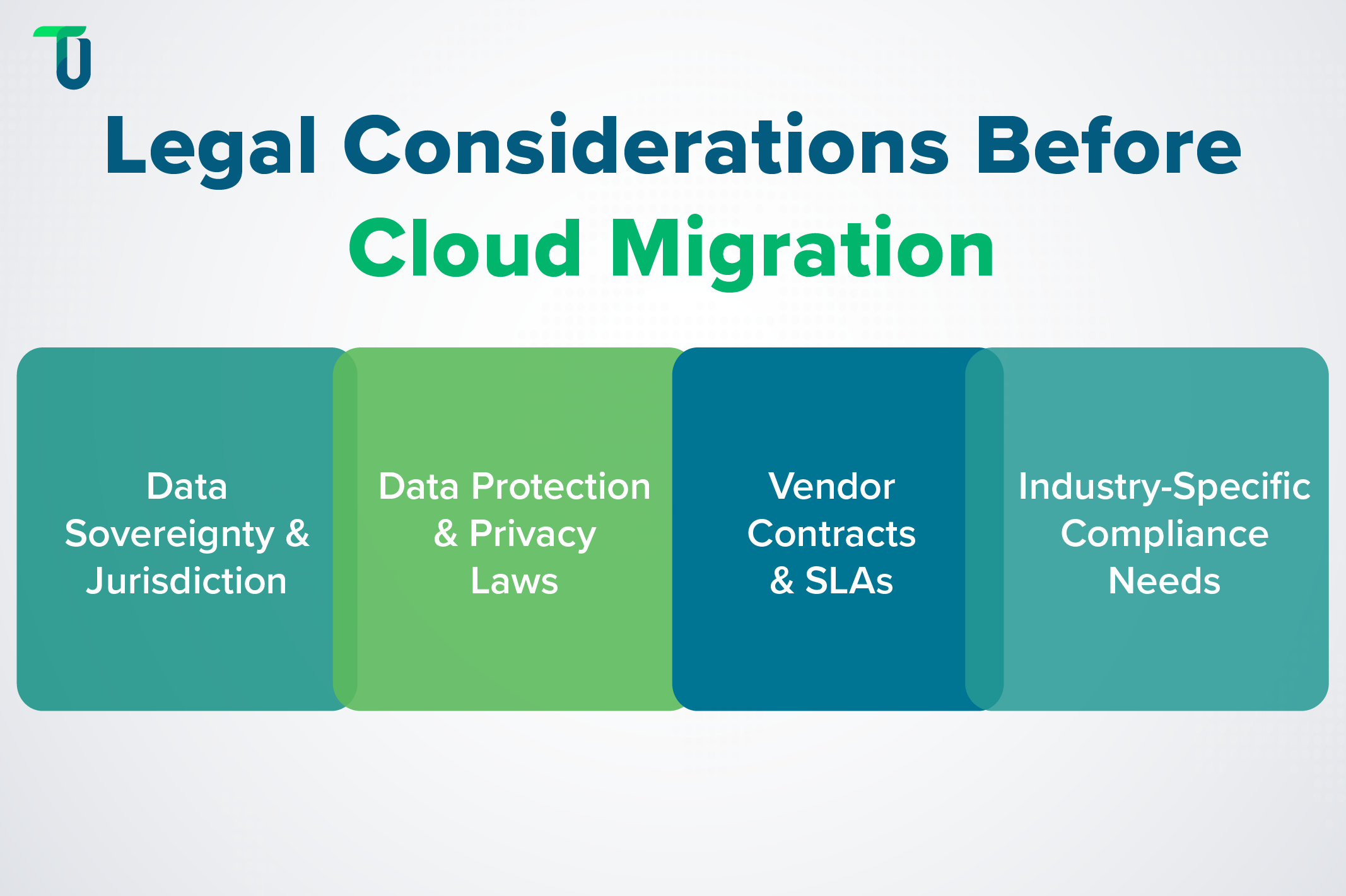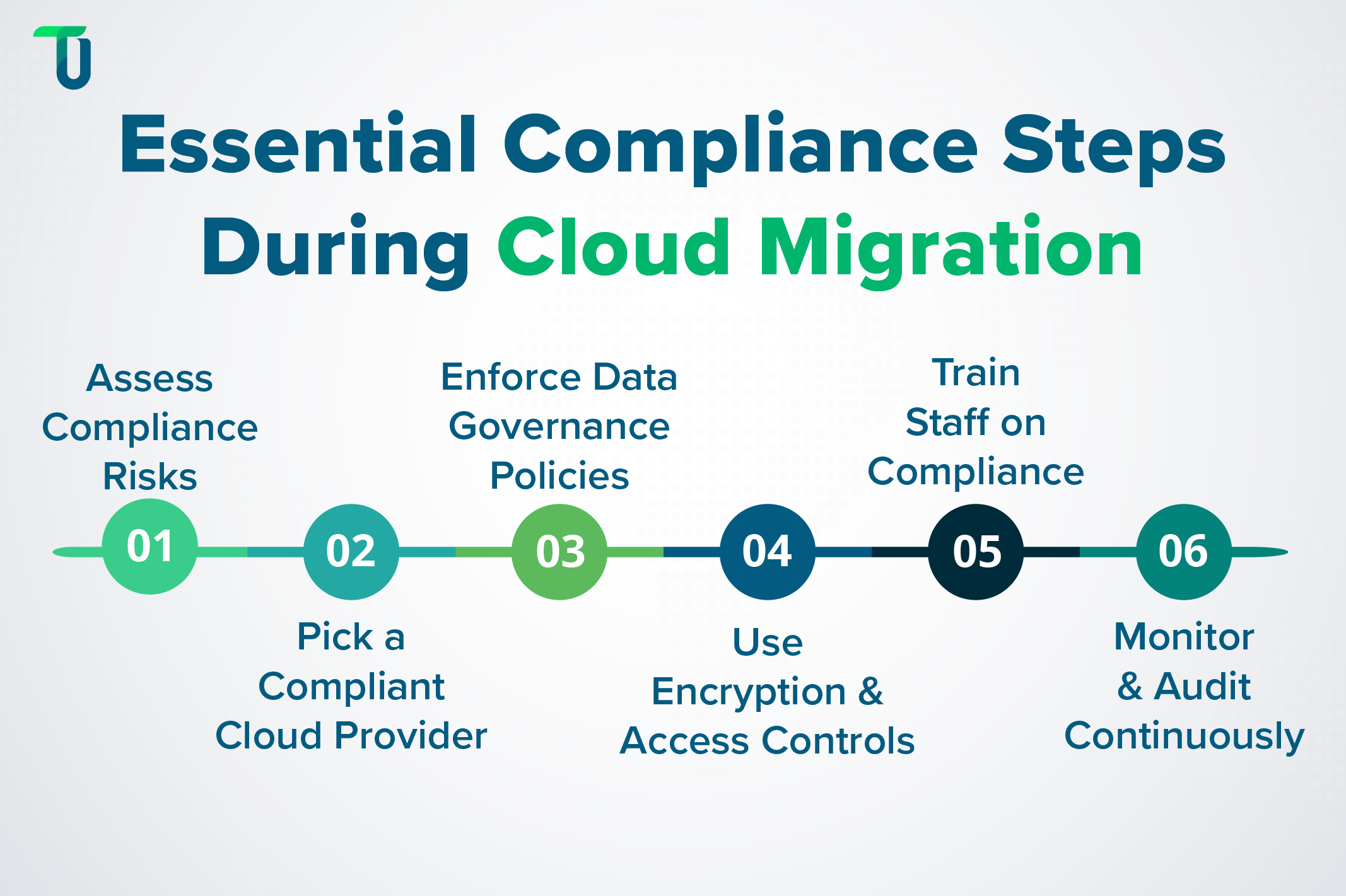Understanding Legal and Regulatory Frameworks
Compliance doesn’t start after cloud migration—it starts before the first workload is moved. Understanding the legal and regulatory landscape becomes non-negotiable when data crosses environments, borders, and jurisdictions.
Key Regulations Impacting Cloud Migration
Whether you're migrating customer data, healthcare records, or payment details, you’re likely bound by at least one of these major compliance frameworks:
GDPR: If you handle personal data of EU citizens, GDPR applies regardless of where your organization is based. It mandates strict rules on data processing, consent, and cross-border transfers.
HIPAA: U.S.-based healthcare providers and partners must ensure that ePHI (electronic protected health information) is securely handled, even when stored or processed in the cloud.
PCI DSS (Payment Card Industry Data Security Standard): Any business dealing with credit card data must meet PCI DSS requirements for encryption, access control, and secure storage during and after cloud migration.
ISO/IEC 27001: While not a regulation, this global security standard provides a strong framework for information security management. It is often used to demonstrate due diligence to regulators and customers alike.
Industry-Specific Compliance Requirements
Compliance isn’t one-size-fits-all. Different sectors have different expectations. Below is a detailed explanation of each:
Financial Services: Expect oversight from regulators like the SEC, FCA, or MAS. Compliance includes data localization, audit trails, and strict incident reporting. Cloud vendors must often be pre-approved or meet specific control requirements.
Healthcare: Beyond HIPAA, many countries have localized regulations (e.g., Canada’s PIPEDA, Australia’s Privacy Act) with unique interpretations of data privacy and patient rights.
Government & Public Sector: Public data often falls under national sovereignty rules. Some jurisdictions demand that sensitive workloads remain within national borders, using accredited cloud environments (e.g., FedRAMP in the U.S.).
Geo-Political Challenges & IT Laws Affecting Cloud Migration
Cloud migration isn’t just a tech decision—it’s a legal and political one too. With rising geo-political tensions and strict IT laws, where your data lives matters more than ever.
From GDPR to Canada’s PIPEDA and Australia’s Privacy Act, global rules are changing how businesses handle cloud strategy. You must factor in borders, policies, and data sovereignty from day one to stay compliant and secure.
Data Residency Laws: Some countries (e.g., China, Russia, UAE) require that citizen data be stored and processed locally, impacting your cloud architecture choices.
Cross-Border Transfer Restrictions: Frameworks like GDPR limit how and where data can be moved. The invalidation of Privacy Shield and evolving mechanisms like SCCs (Standard Contractual Clauses) mean businesses need to stay agile.
Evolving Tech Regulations: Laws such as EU’s Digital Markets Act are reshaping how companies handle user data, consent, and vendor accountability in cloud environments.
Also Read: Tenant Data Isolation Ensures Data Protection & Compliance for SaaS Apps
Avoid the Legal Pitfalls Before They Cost You
Talk to our experts and build a cloud roadmap that keeps you secure, compliant, and ready for what’s next.
Key Legal Considerations Before Migrating to the Cloud
A solid Cloud Migration Strategy isn’t just about moving fast or cutting costs. It’s about moving smart—with your legal risks covered. Here’s what to look out for before you hit “migrate.”

Data Sovereignty & Jurisdiction: Where your data lives matters more than you think. Many businesses use global cloud providers like AWS, Azure, or Google Cloud. However, not all regions treat data the same. For example, Europe’s GDPR has strict rules on cross-border data transfers. Countries like Canada and Australia also enforce strong data localization policies.
If your cloud data ends up in the wrong region, you could violate laws without realizing it.
What to do? Make data residency part of your cloud migration planning. Choose cloud regions that meet your legal needs. Ask your provider where your data will be stored—and whether you have control over it.
Data Protection & Privacy Laws: Privacy regulations are getting tougher every year. GDPR (EU), CCPA (California), and others are changing how businesses collect, store, and share data. You risk fines and lawsuits if your cloud setup doesn’t meet those standards.
The issue? Cloud environments are complex. If encryption isn’t correctly implemented or access controls are too loose, sensitive data can leak.
What to do? Encrypt everything—data at rest and in transit. Use role-based access controls. Anonymize personal data wherever possible. And work with providers that offer compliance-ready infrastructure.
Vendor Contracts & SLAs: Not all cloud contracts are created equal. Some providers offer little accountability when things go wrong—like service outages, data loss, or breaches. Before you sign, review the fine print.
What to do? Check the SLA (Service Level Agreement) for uptime guarantees. Understand the provider’s liability in case of a breach. And have an exit strategy—how will you retrieve your data if you switch providers later?
Industry-Specific Compliance Needs: One more thing- not all industries play by the same rules. You have extra boxes to check if you’re in healthcare, finance, or retail.
HIPAA, PCI DSS, SOX, and others add layers of compliance that go beyond standard cloud setup.
What to do? Map your industry’s compliance needs to your cloud plan. Choose providers certified in your domain. And document every step of your on-premise to cloud migration to stay audit-ready.
Critical Steps to Ensure Compliance During Cloud Migration
Cloud migration is more than moving workloads. It’s about doing it right—with compliance baked into every step. Because once the data’s in the cloud, it’s more complex (and costlier) to fix mistakes. Here’s how to stay safe from day one and keep your enterprise far from hefty cloud migration costs and penalties.

Step 1: Conduct a Compliance Risk Assessment
Before you move anything, take a pause. What kind of data are you handling? What laws apply—GDPR, HIPAA, CCPA? Which teams own what? Many companies skip this and end up playing catch-up post-migration.
Tip: List all regulatory requirements tied to your cloud data migration strategy. Then map out the gaps in your current system. This isn’t just IT’s job—bring in legal, compliance, and security early in the process.
Step 2: Choose a Compliant Cloud Provider
Not all cloud providers are created equal. Some are certified for healthcare (HIPAA), finance (PCI DSS), or government workloads (FedRAMP). Others… not so much.
Tip: Look beyond the sales pitch. Ask for proof—certifications, compliance reports, and security protocols. And ensure their data centers meet your jurisdiction needs.
Step 3: Implement Strong Data Governance Policies
Once in the cloud, your data doesn’t just sit there—it moves, scales, and gets accessed 24/7. That’s why governance matters.
Tip: Set clear policies around who can access what, how long data is retained, and what happens when employees leave. Use automation to enforce rules consistently.
Step 4: Ensure Proper Data Encryption & Access Controls
Encryption isn’t optional. It’s the baseline. Same with access controls—no more shared passwords or “admin for all” policies.
Tip: Encrypt everything—at rest and in transit. Use multi-factor authentication. Apply the principle of least privilege: give users access only to what they absolutely need.
Step 5: Train Employees on Compliance Requirements
Most breaches don’t come from hackers. They come from insiders clicking the wrong link or uploading files to the wrong folder.
Tip: Run regular training sessions. Make compliance part of onboarding. And simplify policies so people actually follow them.
Step 6: Continuous Monitoring & Auditing
Compliance isn’t “set and forget.” Things change. Users get added. Policies drift. That’s why real-time visibility matters.
Tip: Set up tools to monitor data movement, access logs, and unusual activity. Automate alerts for violations. And schedule regular internal audits—not just annual ones.
Also Read: How Legacy Migration Reinforces Compliance
Real-life Examples of Compliance Failures & Successes
Sometimes, the best lessons come from what others got wrong—or right. Let’s look at two real-world stories that show why compliance can’t be an afterthought in your cloud migration strategy.
Failure: Capital One’s Cloud Misconfiguration Breach
In 2019, Capital One migrated a big part of its infrastructure to AWS. But a simple misconfiguration in their cloud firewall gave a former employee access to over 100 million customer records, including names, addresses, credit scores, and even social security numbers.
The worst part? It wasn’t a complex hack. It was a missed security setting that could have been caught with stronger compliance checks and better governance.
This breach led to regulatory fines, a $190 million settlement with affected users, and long-term reputation damage.
Key Lesson: Cloud-native doesn’t mean secure-by-default. Compliance must be embedded at every layer—from identity access to data storage.
Success: Johnson & Johnson's Compliant Cloud Migration
Johnson & Johnson, a global healthcare leader, faced the challenge of securely managing vast amounts of data across its operations. By leveraging AWS services like Amazon EBS and Amazon WorkSpaces, they implemented a scalable, secure, and compliant cloud infrastructure. Notably, they utilized Amazon EBS Snapshots Archive to retain data cost-effectively for long-term compliance needs, achieving over $1 million in annual storage savings.
Key Takeaway: Integrating compliance considerations into the cloud migration strategy from the outset can lead to both regulatory adherence and operational efficiencies.
These case studies illustrate that while cloud migration offers numerous benefits, overlooking compliance can lead to severe repercussions. You can avoid these challenges by choosing a professional cloud migration service provider to help you build a secure and agile business on the cloud with all compliance and security.
Also Read: How we implemented enterprise data security for a client
Notable Future Trends in Cloud Compliance
Cloud compliance isn’t standing still. It’s moving fast—and businesses need to keep up. Here’s what’s coming next.
First, expect tighter data laws. Countries are rolling out stricter rules around privacy, cross-border data transfers, and AI. The EU’s AI Act is one example. It sets limits on how AI systems collect and use personal data. Similar laws are popping up in Canada, the U.S., and Asia.
Second, the move toward Zero-Trust security is gaining speed. This model doesn’t assume anything is safe—not even your internal users. Every access request must be verified. It’s already the standard in many Fortune 500 companies and will soon be the baseline for any on-premise to cloud migration strategy.
Finally, there’s automation. Manual audits give way to smart tools that track compliance in real time. Think dashboards, alerts, and auto-generated reports. These tools reduce human error and help businesses stay ahead of regulators.
The future of cloud compliance is clear: more rules, smarter defenses, and fewer chances to wing it. If your cloud strategy doesn’t plan for this now, you’ll be playing catch-up tomorrow.
Don’t Just Migrate. Migrate Smart—with Compliance Built In
Cloud migration isn’t just about moving your apps. It’s about driving responsibly. And legally.
From data sovereignty and privacy laws to industry-specific compliance needs, we’ve covered how regulations can make—or break—your cloud journey. It’s no longer enough to tick checkboxes. You need a cloud migration strategy that bakes compliance into every layer—right from risk assessment to vendor selection to data governance.
The truth? Waiting to “fix compliance later” is a shortcut to audits, penalties, and public trust issues
Our advice: start early, plan smart, and choose a partner who gets it.
At TenUp, we don’t believe in lift-and-shift. We help you assess risk, meet regulatory demands, and build a secure, compliant cloud foundation without slowing down your goals. From healthcare to finance, we’ve helped enterprises achieve compliance confidently and cost-effectively with our prominent cloud solutions and migration services. Because in the cloud, compliance isn’t a box to check. It’s your license to scale.
Ready to migrate with peace of mind? Let’s build your compliant cloud strategy—together.
Migrate with Confidence, Not Chaos
Get a custom cloud migration strategy that bakes compliance into every step—from planning to execution.
Frequently asked questions
How do I select the best cloud service provider for my organization's needs?
Selecting a cloud provider involves evaluating factors such as compliance requirements, existing technology stack compatibility, cost structures, and specific service offerings. For instance, AWS, Azure, and Google Cloud each have unique strengths that may align differently with your organization's objectives.
How to mitigate the cloud migration challenges?
Mitigating common challenges during cloud migration, like data integrity issues, downtime during migration, and ensuring continued operations, require strategies involving thorough planning, phased migration approaches, and leveraging tools provided by cloud providers to ensure a smooth transition.
How can I ensure data security and compliance during and after cloud migration?
Ensuring data security involves implementing strong encryption, access controls, and continuous monitoring. Compliance can be maintained by understanding relevant regulations and choosing cloud services that offer necessary certifications and compliance support.
How do I estimate and manage the costs associated with cloud migration?
Estimating cloud migration costs involves considering factors like data transfer, application redesign, and ongoing cloud service fees. Effective cost management includes optimizing workloads, using cost calculators, and monitoring usage to prevent overruns.
What are the best practices for minimizing downtime during cloud migration?
Minimizing downtime can be achieved through strategies like phased migration, thorough testing in staging environments, and implementing failover mechanisms to maintain service availability during the transition.
What are the 6 R’s of cloud migration?
The 6 R’s are common strategies used for cloud migration:
Rehost – Move as-is (lift and shift)
Replatform – Make minor optimizations
Repurchase – Replace with a SaaS solution
Refactor – Redesign for cloud-native features
Retire – Decommission unused apps
Retain – Keep apps on-premise for now

